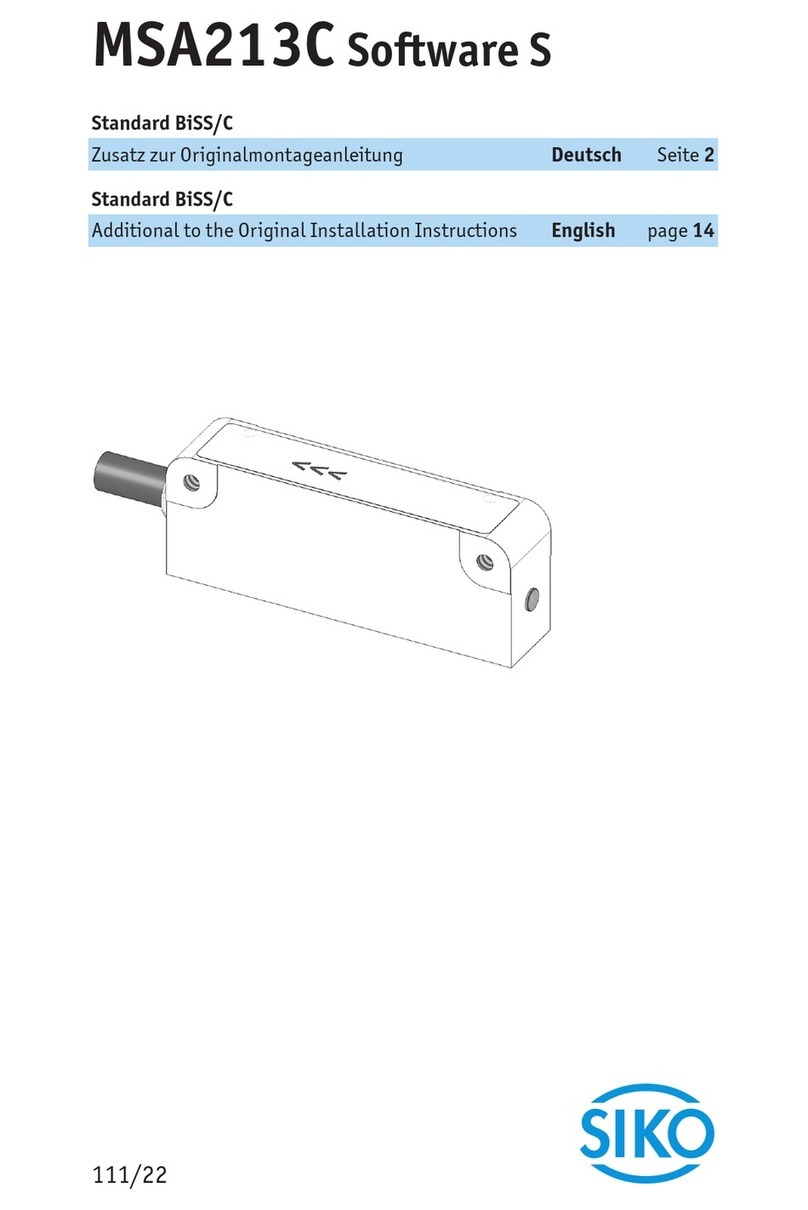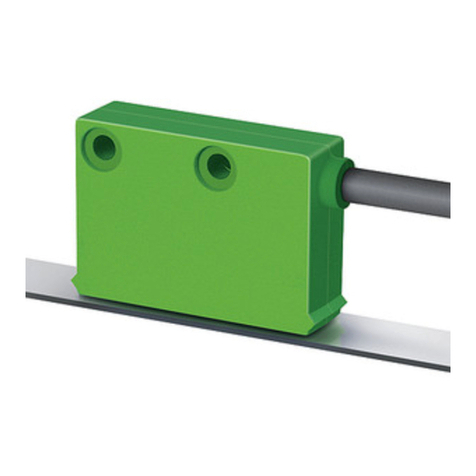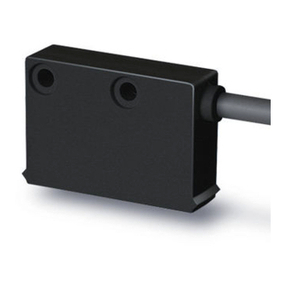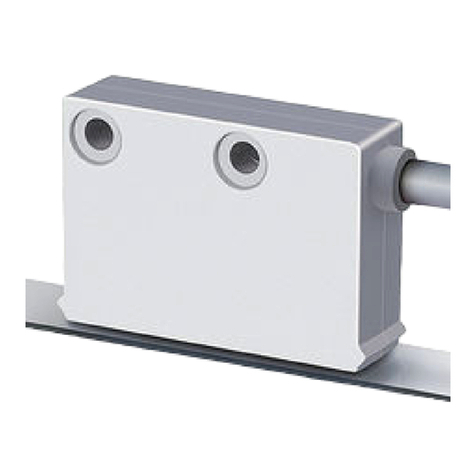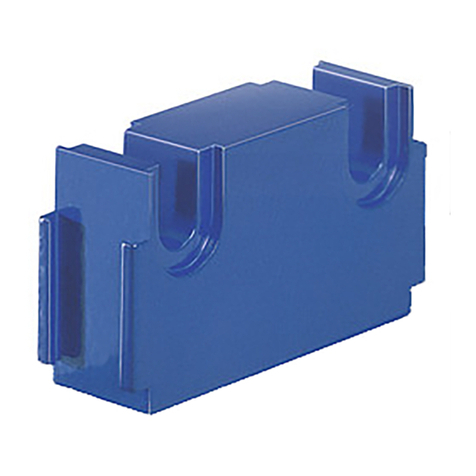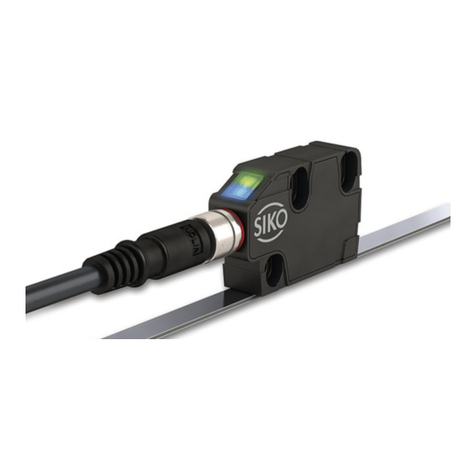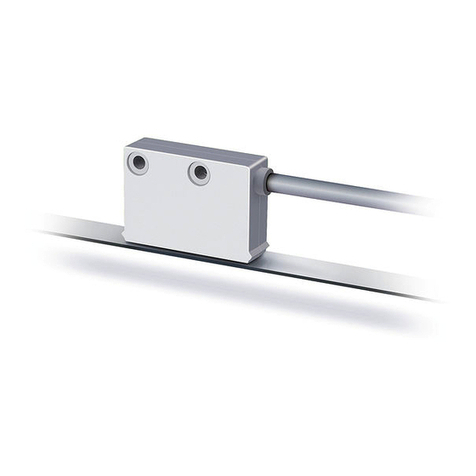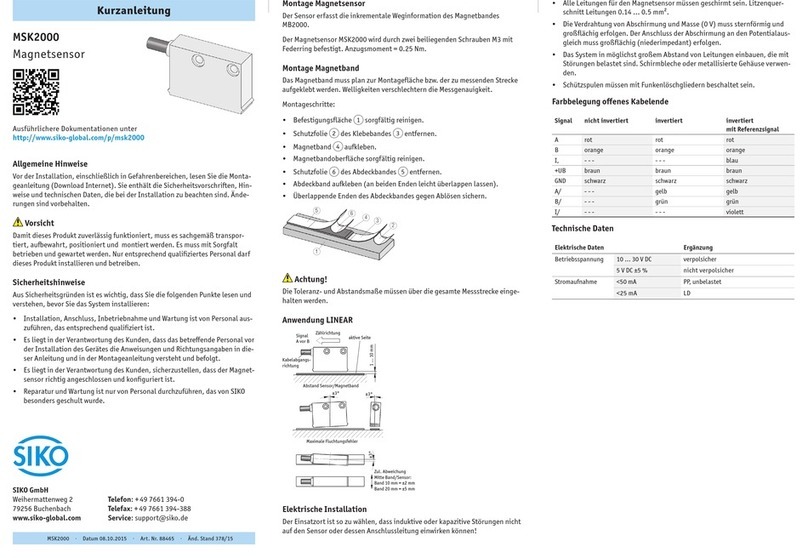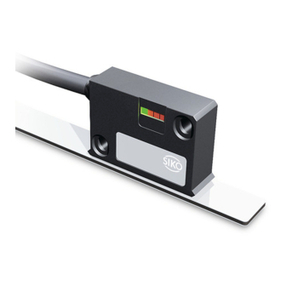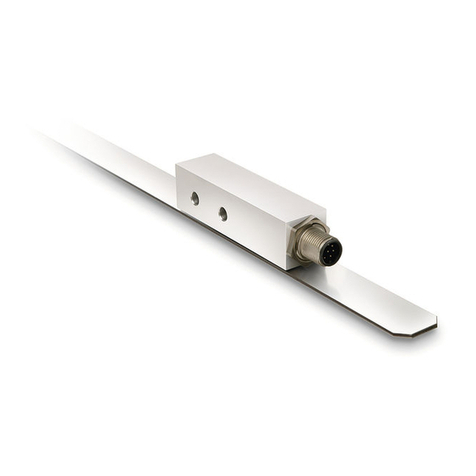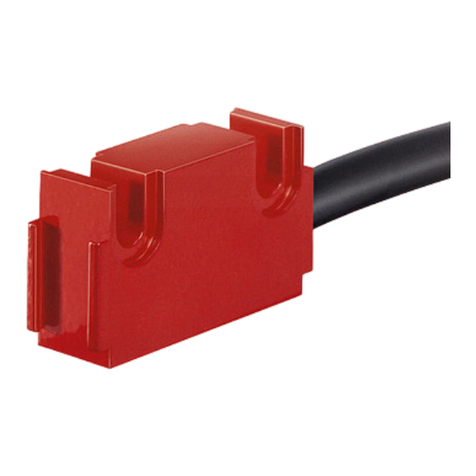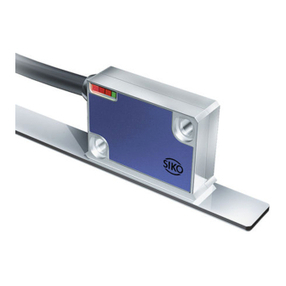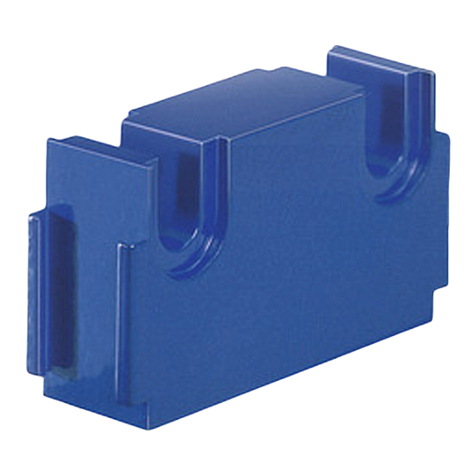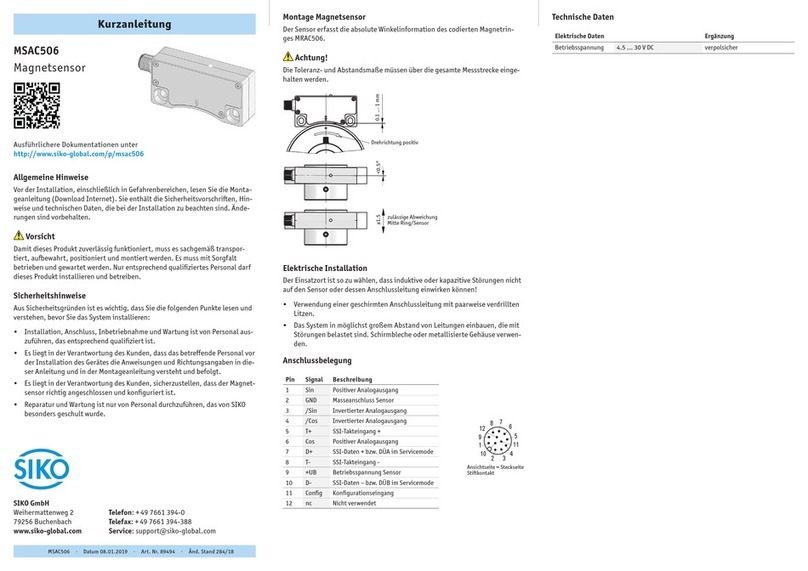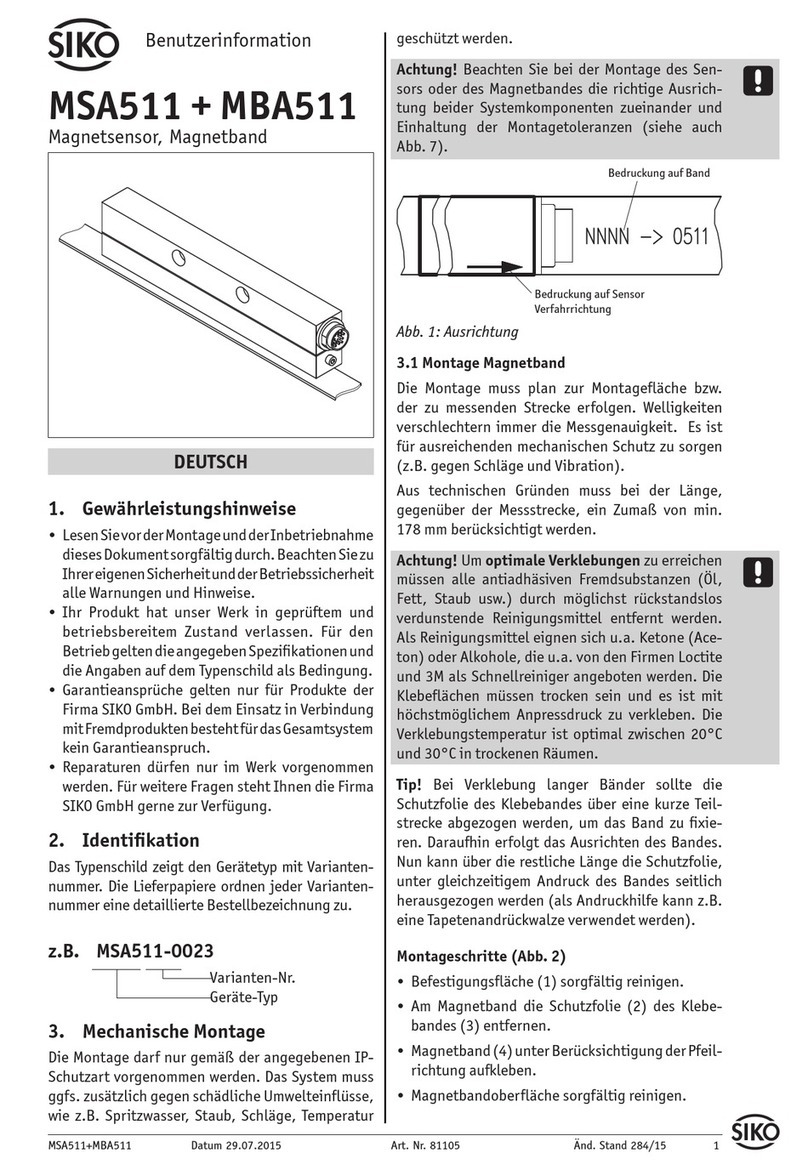Siko GP43 Operation manual

GP43/44/63/64 Datum 19.09.2002 Art.Nr. 79804 Z.Nr. 8604015 Änd.Stand 284/02 1
meter wird der mechanische Drehwinkel der 1- oder
10-Wendel-Potentiometer dem zu messenden Be-
reich angepaßt. Eine Rutschkupplung zwischen
Getriebe und Potentiometer verhindert die mecha-
nische Zerstörung des Potentiometers beim Über-
fahren des Endanschlags (nur bei 10-Wendel-Po-
tentiometer, das 1-Wendel-Potetentiometer hat
keinen Endanschlag).
Die Getriebepotentiometer GP63/64 sind mit einem
Messwertwandlerausgerüstet. DieWiderstandswerte
der Potentiometerstellung werden in einen Schlei-
fenstrom von 4 ... 20 mA umgewandelt. Dies ermög-
licht eine Übertragung des Messwerts unabhängig
vom Widerstand der Übertragungsleitung.
Die maximal 3 Schaltnocken bieten die Möglich-
keit, drei Schaltvorgänge zu steuern.
4. Garantiehinweise
Gehen Sie sorgfältig mit dem Geber um. Es handelt
sich um ein Präzisionsmessgerät. Folgende Punkte
führen unverzüglich zum Verfall der Garantie:
• Zerlegen oder Öffnen des Gebers (soweit dies nicht
in dieser Benutzerinformation beschrieben wird).
• Unsachgemäße Kupplung der Geberwelle z.B. mit
steifen Kupplungen, die zu große Kräfte auf die
Lagerung der Geberwelle erzeugen. Verwenden Sie
bei Vollwellengebern die SIKO-Ausgleichskupplung
Typ AK18.
• Schläge auf das Gehäuse und die Welle beschädi-
gen den Geber bzw. innere Teile und sind nicht
zulässig.
• Mechanische Bearbeitung der Welle, des Flan-
sches oder Gehäuses (Bohren, Fräsen, usw.). Hier-
durch kann es zu schweren Beschädigungen der
inneren Teile des Gebers kommen.
• UnzulässigeaxialeoderradialeBelastung derWelle.
• Unsachgemäße Befestigung des Gebers.
Was Sie nicht tun sollten
Benutzerinformation
GP43/44/63/64
Getriebepotentiometer mit Endschalter
DEUTSCH
1. Gewährleistungshinweise
• Lesen Sie vor der Montage und der Inbetriebnah-
me dieses Dokument sorgfältig durch. Beachten Sie
zu Ihrer eigenen Sicherheit und der Betriebssicher-
heit alle Warnungen und Hinweise.
• Ihr Produkt hat unser Werk in geprüftem und
betriebsbereitem Zustand verlassen. Für den Be-
trieb gelten die angegeben Spezifikationen und
die Angaben auf dem Typenschild als Bedingung.
• Garantieansprüche gelten nur für Produkte der
Firma SIKO GmbH. Bei dem Einsatz in Verbindung
mit Fremdprodukten besteht für das Gesamtsystem
kein Garantieanspruch.
• Reparaturen dürfen nur im Werk vorgenommen
werden. Für weitere Fragen steht Ihnen die Firma
SIKO GmbH gerne zur Verfügung.
2. Identifikation
Das Typenschild zeigt den Gerätetyp mit Varianten-
nummer. Die Lieferpapiere ordnen jeder Varianten-
nummer eine detaillierte Bestellbezeichnung zu.
z.B. GP43-0023
Varianten-Nr.
Geräte-Typ
3. Kurzbeschreibung
Die Getriebepotentiometer zeichnen sich durch
robuste Konstruktion und kompakte Bauform aus.
Durch die Kombination von Getriebe und Potentio-
GP43/63
GP44/64

2 GP43/44/63/64 Datum 19.09.2002 Art.Nr. 79804 Z.Nr. 8604015 Änd.Stand 284/02
5. Mechanische Montage
Die Montage darf nur gemäß der angegebenen IP-
Schutzart vorgenommen werden. Das System muss
ggfs. zusätzlich gegen schädliche Umwelteinflüsse,
wie z.B. Spritzwasser, Staub, Schläge, Temperatur
geschützt werden.
AnbaudesGebers
•Die Befestigung erfolgt durch Bohrungen an der
Stirnfläche des Gebers. Montieren Sie den Geber
verspannungsfrei.
•Kräfte dürfen nicht durch das Gehäuse übertra-
gen werden. Sie dürfen ausschließlich an der Welle
des Geräts wirken.
•Beachten Sie die maximalen axialen und radialen
Wellenbelastungen.
•Achten Sie auf geringen Wellen- und Winkelver-
satz. Bei nicht korrekter axialer oder winkliger
Stellung zwischen Welle und Flansch entstehen
Spannungen im Lager, die über erhöhte Erwärmung
bis zur Zerstörung der Lager führen können.
6. Elektrischer Anschluss
• Anschlussverbindungen dürfen nicht unter
Spannung geschlossen oder gelöst werden!!
•Verdrahtungsarbeiten dürfen nur spannungslos
erfolgen.
•Litzen sind mit Aderendhülsen zu versehen.
•Vor dem Einschalten sind alle Leitungsanschlüs-
se und Steckverbindungen zu überprüfen.
Hinweise zur Störsicherheit
Alle Anschlüsse sind gegen äußere Störeinflüsse
geschützt. Der Einsatzort ist aber so zu wählen,
dass induktive oder kapazitive Störungen nicht
auf die Anzeige oder deren Anschlussleitungen
einwirken können ! Durch geeignete Kabelfüh-
rung und Verdrahtung können Störeinflüsse (z.B.
von Schaltnetzteilen, Motoren, getakteten Reglern
oder Schützen) vermindert werden.
Erforderliche Maßnahmen:
• Nur geschirmtes Kabel verwenden. Den Kabel-
schirm beidseitig auflegen. Litzenquerschnitt der
Leitungen min. 0,14 mm2, max. 0,5 mm2.
• Die Verdrahtung von Abschirmung und Masse
(0V) muss sternförmig und großflächig erfolgen.
Der Anschluss der Abschirmung an den Potential-
ausgleich muss großflächig (niederimpedant) er-
folgen.
• Das System muss in möglichst großem Abstand
von Leitungen eingebaut werden, die mit Störun-
gen belastet sind; ggfs. sind zusätzliche Maßnah-
men wie Schirmbleche oder metallisierte Gehäu-
se vorzusehen. Leitungsführungen parallel zu Ener-
gieleitungen vermeiden.
• Schützspulen müssen mit Funkenlöschgliedern
beschaltet sein.
Speisespannung Messwandler
Die Spannungswerte sind abhängig von der Geräte-
ausführung und sind den Lieferpapieren oder dem
Typenschild zu entnehmen.
20 ... 28 VDC
6.1 Öffnen und Schließen des Geräts
Öffnen:
•Zum öffnen des Gerätes entfernen Sie die Befesti-
gungsschrauben an der Haube GP44/64 bzw. an der
Rückwand GP43/63.
•Stellen Sie sicher, dass der O-Ring nicht beschä-
digt wird oder verloren geht.
Schließen:
Zum einfacheren Verschließen und zur Vermeidung
von Kabelbeschädigungen ist es ratsam, die innen
liegenden Litzen mit einem Klebeband zu befesti-
gen. Verwenden Sie nur geeignetes Klebeband, das
sich nicht durch Temperatur oder Alterung löst.
(Nur GP44/64)
•Prüfen Sie, ob der O-Ring korrekt in der Nut
liegt.
•Setzen Sie die Gehäusehaube/Rückwand auf den
Flansch auf. Beachten Sie dabei, dass der O-Ring
nicht beschädigt wird.
•Ziehen Sie die Befestigungsschrauben fest an.
Abb. 1: Befestigung der Litzen
Klebeband

GP43/44/63/64 Datum 19.09.2002 Art.Nr. 79804 Z.Nr. 8604015 Änd.Stand 284/02 3
6.2 Anschluss der Kabel
•Die Kabel gemäß Abb. 2 vorbereiten
•Öffnen Sie das Gerät (siehe Kap. 6.1) und demon-
tieren Sie die PG-Verschraubung.
Abb. 2: Kabelvorbereitung
Bei PG7 (Abb. 3) :
•Schieben sie die Mutter (1) und den Kunststoff-
einsatz (2) auf das Kabel.
•Das Abschirmgeflecht (3) über den Kunststoff-
einsatz (2) zurückstülpen.
•Litzen durch die Verschraubung (4) schieben.
Kunststoffeinsatz (2) in die Verschraubung einpas-
sen.
•Die Mutter (1) aufschrauben und die komplette
Verschraubung an der Haube anbringen.
Abb. 3: Kabelanschluss PG7
Bei PG9 (Abb. 4) :
•Schieben sie die Mutter mit Dichtungsgummi
(1), Scheibe (2) (Innen-ø > Innen-ø Scheibe (4))
und Scheibe (4) auf das Kabel.
•Das Abschirmgeflecht (3) über die Außenfläche
der Scheibe (2) zurückstülpen.
•Litzen durch die Verschraubung (5) schieben.
Einpassen der Teile (4), (3), und (2) in die Ver-
schraubung (5).
•Die Mutter (1) aufschrauben und die komplette
Verschraubung an der Haube anbringen.
Abb. 4: Kabelanschluss PG9
•Litzen an den Klemmen des Gerätes anschließen
(Abb. 5 und 6).
•Schließen Sie das Gerät (siehe Kap. 6.1).
Abb. 5: Anschlussbelegung GP43/44
Abb. 6: Anschlussbelegung GP63/64 mit Messwandler
Potentiometer
Schaltnocken
Potentiometer/Messwandler
*Nockenschalter
Aderend-
hülse
Schrumpfschlauch
Steuerleitung :
- 2x0.25mm2bzw. 3x0.25mm2
- *max. 7x0.5mm2(Anzahl der Nocken x 2) +1
GP43/63
GP44/64
Aderend-
hülse
Schrumpfschlauch
Schaltnocken
Messwandler
Ausgang

4 GP43/44/63/64 Datum 19.09.2002 Art.Nr. 79804 Z.Nr. 8604015 Änd.Stand 284/02
7. Einstellung und Abgleich
7.1 Allgemeine Hinweise
Definition der Drehrichtung:
Abb. 7: Definition der Drehrichtung
Für GP43/44 gilt:
Bei Drehrichtung "i" und voll auf Endanschlag in
Richtung "e" gedrehter Welle ist der Potentiome-
terwert am Schleifer S gegenüber dem Potentiome-
teranfang Po gleich 0 Ohm. Er steigt gegenüber Po,
wenn die Welle in Richtung "i" gedreht wird.
Bei Drehrichtung "e" und voll auf Endanschlag in
Richtung "i" gedrehter Welle ist der Potentiome-
terwert am Schleifer S gegenüber dem Potentiome-
teranfang Po gleich 0 Ohm. Er steigt gegenüber Po,
wenn die Welle in Richtung "e" gedreht wird.
Für GP63/64 gilt:
...sinngemäß dasselbe wie für GP43/44, jedoch
beginnt der Strom des Messwandlers bei niedrigen
Werten und steigt jeweils zum Endwert an (siehe
Abschnitt 7.4).
7.2 Einrichtung Potentiometer
Nach ordnungsgemäßem Anschluss zeigt das Gerät
bei Einschalten der Betriebsspannung den aktuel-
len Istwert.
7.3 Einstellung der Nockenschalter
Die Schaltnocken sind im Auslieferungszustand
radial nicht auf der Welle befestigt. Die Einstellung
erfolgt, nachdem das Gerät am Maschinenkörper
angebaut wurde.
Wichtiger Hinweis!
Berühren Sie bei den Einstellarbeiten die Rollenhe-
bel der Schalter nicht: Sie könnten verbogen wer-
den und nicht mehr korrekt funktionieren.
•Bringen Sie die drehbaren Nocken (A, B, C) in eine
zur Feineinstellung günstige Position: Gewindestift
(1) und Schraubrad (2) sollen gut erreichbar sein.
•Sichern Sie jeweils die Nocken durch Anziehen
der Gewindestifte (1) gegen Verdrehen.
•Die Feineinstellung der Nockenscheibe erfolgt
durch drehen der Feineinstellschraube (2) mittels
Schraubendreher Größe 3 (siehe Abb. 8).
Abb. 8: Einstellung der Schaltnocken
Abb.9: Nomogramm : Belastbarkeit der Nockenschalter
7.4 Abgleich des Messwandlers (nur für GP63/64)
Das Gerät GP63/64 ist mit einem Widerstands-
stromwandler ausgestattet. Der Potentiometer-Wi-
derstand wird in einen Strom von 4 ... 20mA
umgewandelt. Es handelt sich um eine Zweileiter-
technik. Der Messstrom dient gleichzeitig zur Ver-
sorgung des Wandlers.
Der Messwandler ist bei Auslieferung auf Standard-
werte 4mA für die Anfangs- (Po) und 20mA für die
Endstellungen (Pe) des Potentiometers abgegli-
chen. Durch zwei Trimmpotentiometer Po und Pe
(siehe Abb. 6) können diese Werte an die
tatsächlichen Anfangs- und Endstellungen der
Anwendung angepaßt werden:
Einstellbarkeit:
•Mit Trimmpotentiometer Po kann ein Strom von
4 mA bei Potentiometerwerten von 0 bis 15% des
Gesamtwertes eingestellt werden.
•Mit Trimmpotentiometer Pe kann ein Strom von
20 mA bei Potentiometerwerten von 90 bis 100%
Innensechs-
kant 1,5
Schrauben-
dreher 3

GP43/44/63/64 Datum 19.09.2002 Art.Nr. 79804 Z.Nr. 8604015 Änd.Stand 284/02 5
des Gesamtwertes eingestellt werden.
Der kleinste nutzbare Bereich des Potentiometers,
in dem 4 ... 20 mA abgegeben werden, beträgt
demnach 15% bis 90% des Potentiometer-Wider-
standsbereichs.
Abgleich
1) Masch. auf Anfangsstellung fahren
2) Linkes Potentiometer (Po) drehen, bis Anfangs-
wert (4mA) gemessen wird.
3) Masch. auf Endstellung fahren
4) Rechtes Potentiometer (Pe) drehen, bis Endwert
(20mA) gemessen wird.
Die Schritte 1 bis 4 sind solange zu wiederholen, bis
die Werte austariert sind (iterativer Abgleich).
Abb. 10: Abgleich
7.5 Was tun wenn... (Messwandler)
...die Drehrichtung grundsätzlich falsch ist?
Dann können Sie:
•entweder die Drehrichtung mechanisch ändern
(durch Bestellung/Änderung der anderen Drehrich-
tung bei SIKO),
•oder den Strom 4 ... 20 mA invertiert auswerten
(4 mA würde dann dem Endwert entsprechen.
Machbar z.B. bei Auswertung mit Software).
... sich die Anfangs- und Endwerte des Strom-
wandlers nicht auf 4 bzw. 20 mA bringen lassen?
•Dann ist vermutlich der Verstellbereich des Po-
tentiometers zu klein (Schleifer bewegt sich inner-
halb des minimalen Bereichs von 15 ... 90% und
überstreicht einen zu kleinen Widerstandsbereich)
•Prüfen Sie, ob Sie mit dem kleineren Strombe-
reich auskommen können, andernfalls müssen Sie
die Übersetzung des Getriebes entsprechen anpas-
sen (durch Bestellung/Änderung einer anderen
Übersetzung bei SIKO).
Was tun wenn... (Potentiometer)
... ein undefinierter Wert angezeigt wird?
•Es muss ein Neuabgleich oder Feinabgleich vor-
genommen werden. Mögliche Ursache kann auch
eine Leitungsunterbrechung sein.
8. Inbetriebnahme
Bitte beachten Sie die Hinweise auf ordnungsge-
mäßen mechanischen und elektrischen Anschluss
in Kapiteln 5 und 6. Nur dann sind die Vorausset-
zungen für eine problemlose Inbetriebnahme und
einwandfreien Betrieb gegeben.
Prüfen Sie vor der Inbetriebnahme nochmals auf:
• korrekte Polung der Betriebsspannung
• korrekten Anschluss der Kabel
• einwandfreie Montage des Geräts
Strom
Messweg
20mA
4mA (Po)
(Pe)
0
Other manuals for GP43
2
This manual suits for next models
3
Table of contents
Languages:
Other Siko Accessories manuals

